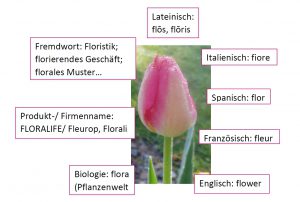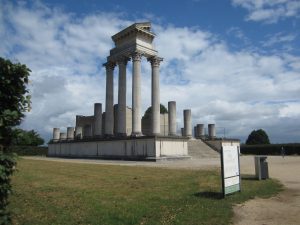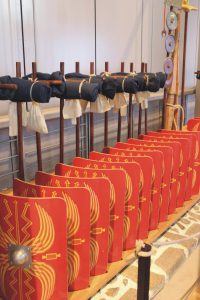Latin
Hinweis: Dies ist eine automatische Übersetzung des Seiteninhalts (English). Für verbindliche Informationen gilt der deutsche Originaltext. Original anzeigen
Note: This is an automatic translation of the page content (English). For authoritative information, the German original text applies. Show original
| Grade levels | 6-10 (alternative to French), S1-4 (elective) |
| Fachkollegen | Bor, Ha, Hed, La, Sma |
| Fachräume | 1 Latin room with interactive projector |

Quid ad nos? – What does Latin have to do with us?
Language of Europe
Why learn a language that is no longer spoken?
Rome was considered the world power of antiquity for many centuries. 2000 years ago, the Roman Empire stretched across the entire Mediterranean, and its borders reached from North Africa to the shores of modern Scotland, from Portugal to Mesopotamia in the east. Latin was spoken everywhere, just as English is spoken today. After the fall of the Roman Empire, the Latin language survived to the present day. Latin is still regarded as the language of science, medicine, law, and the Church. The influence of Latin is particularly visible in the Romance languages (e.g., Italian, Spanish, French) and in English, as well as loanwords in German. Knowing and using Latin loanwords today still signals a refined style of language. In advertising we encounter Latin-derived product and company names daily.

General Education
Not only the language of the Romans, but also their history, culture, and thinking – the Romans and the Greeks – continue to shape Europe today.
How did the Romans live? What did they believe? Which gods did they worship and why? How did the Romans spend their leisure time? What fascination did chariot races and gladiator contests exert? What moral standards guided people in antiquity? What does pietas, virtus, and luck mean? To what extent were Romans influenced by the Greeks? Which exciting myths were told? Which heroes were spoken of? What is the Trojan Horse? Why did Orpheus go to the underworld? Which great figures shaped politics and society? What are Optimates? How could Catiline’s conspiracy be averted? What was the life of a Roman legionary like? What were the Romans doing in Germania? Why did Varus lose his legions? Why do we travel to Xanten?
In dealing with this unfamiliar culture, Latin education contributes in a special way to the personal development of today’s young people. It focuses on historical communication and a deeper understanding of our European roots, mainly through engagement with Latin texts, their interpretation and evaluation of questions raised. Students discover common foundations of European culture and their changes. No other subject makes us more European than Latin.
Or: as Günther Jauch expressed in a 2006 Spiegel interview: “Latin takes detours. It is like a journey: If I want to get from A to B fastest, I take the highway. But the beauty of traveling lies in the stops along the way or the drives through the villages.”
Reading and Expressive Ability in German
With the help of Latin grammar, the German language can be understood well. Translating Latin texts broadens expression in one's mother tongue and fosters logical thinking. In particular, Latin instruction – beside German lessons – contributes to language education when German is not a mother tongue. The goal is always to interpret a Latin text and translate it into German. This is a complex process: accuracy in grammar must be balanced with precise expression and a coherent text structure. Through continual reflection on language, Latin students achieve better text and reading comprehension well beyond Latin class. Learning other foreign languages becomes easier. The model character of Latin contributes to a deeper understanding of language and how language works in general.
LATINUM and GREAT LATINUM Qualifications
After 5 years (starting from grade 6), LATINUM can be earned without further exams if a sufficient performance is achieved at the end of grade 10. For some study subjects, universities require proof of Latin language skills or even the state LATINUM. University regulations vary and often depend on these Latin qualifications for later study planning. In addition to taking and successfully completing Latin courses, pursuing studies can be time-consuming and very demanding.
After 6 years, i.e., continuing the second foreign language in upper level, one can obtain the GREAT LATINUM with successful completion (5 points) without an additional exam.
In short
Latin …
- as the oldest school subject, holds a significant place in the curriculum.
- introduces the world of antiquity.
- opens access to European intellectual and cultural history.
- offers a lot of general education besides the language.
- facilitates learning of other foreign languages.
- trains grammatical understanding of linguistic phenomena.
- deepens, trains, and expands the expressive ability in German.
- builds analytical thinking through text work.
- educates for precision, combinatorial ability and mental agility.
- introduces scientific ways of working.
- fosters problem-solving abilities.
- offers a recognized qualification with the LATINUM certificate.
Latin at GyRa
Latin in lower and middle school
The choice of the second foreign language takes place in the 5th grade. Trial lessons and an informative parents’ evening are held. From grade 6, Latin begins with five periods per week and is gradually reduced in the following years to three hours per week. As in all foreign languages, alongside two class tests per semester, there are vocabulary and grammar tests. The instructional language is German: spelling and pronunciation thus do not pose a major problem.
The three competence areas:
- Text: In Latin, a lot of written work is done. The focus is a Latin text. It is translated into good German linguistically and stylistically and interpreted. This places high demands on Latin students. Solutions are not obvious; often one must combine and deduce logically. In shaping a text, linguistic knowledge and substantive understanding of the text interlock.
- Language: The tools for successful text translation are certainly secure vocabulary and form knowledge. Since Latin is not actively spoken, listening and direct imitation of speech are not available as learning approaches. Gaps are hard to close later. That means regular study, including memorizing forms, endings and systems, is necessary and not always enjoyable. But there lies the great opportunity: those who are diligent are rewarded.
- Culture: For deeper, substantive text understanding, we inform ourselves through expository texts and books, films, or through presentations. Discussions are stimulated. The aim is to examine ancient patterns of thought, ways of life and events and compare them with one’s own life world and finally form one’s own position.
Instructional Design
In recent decades, Latin instruction has significantly approached modern languages. Methodologically, Latin instruction can hold its own with modern foreign languages: text understanding and interpretation through dramatic play, role-playing, tableaux, creative writing, podcasts, reports, comics and picture stories, and more. The use of digital media and the child-friendly and comprehensible presentation of the subject matter in our modern, colorful teaching materials provides an appealing access to Latin.
The Teaching Material:
- Klett: Pontes, Gesamtausgabe (2016)
- Accompanying book (grammar)
- Vocabulary notebook
- Workbook
- numerous additional materials for practice at home
Themes:
First year of study:
- Time travel to ancient Rome (daily life of Romans in the family)
- Tension and relaxation in ancient Rome (public life and leisure in ancient Rome)
Second year of study:
- Myth and early history of Rome (Romance myths: Aeneas; Romulus and Remus)
- The Roman Republic (society and politics; Caesar, Cicero)
- extracurricular: trip to Xanten (Roman life in a Germanic province)




